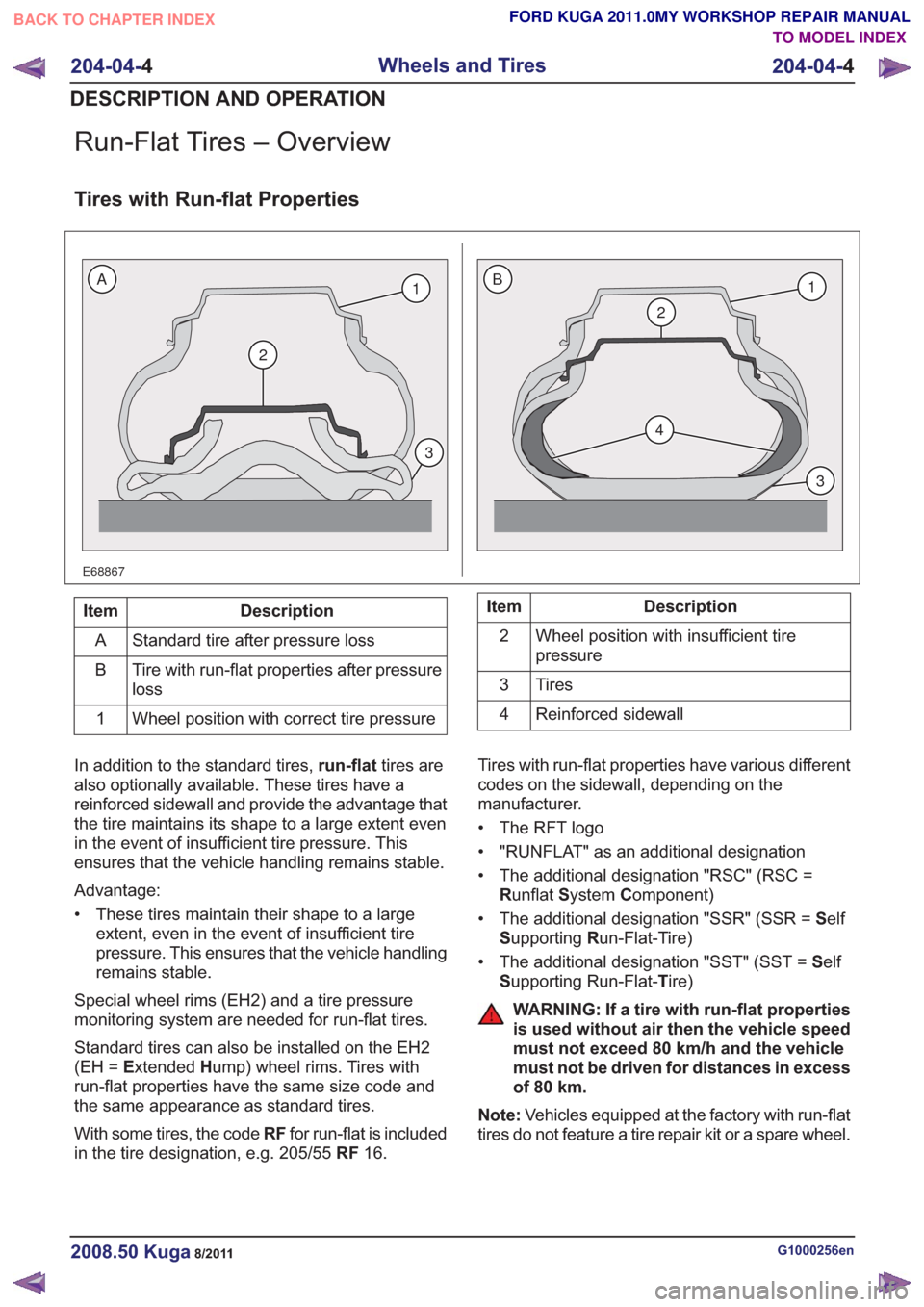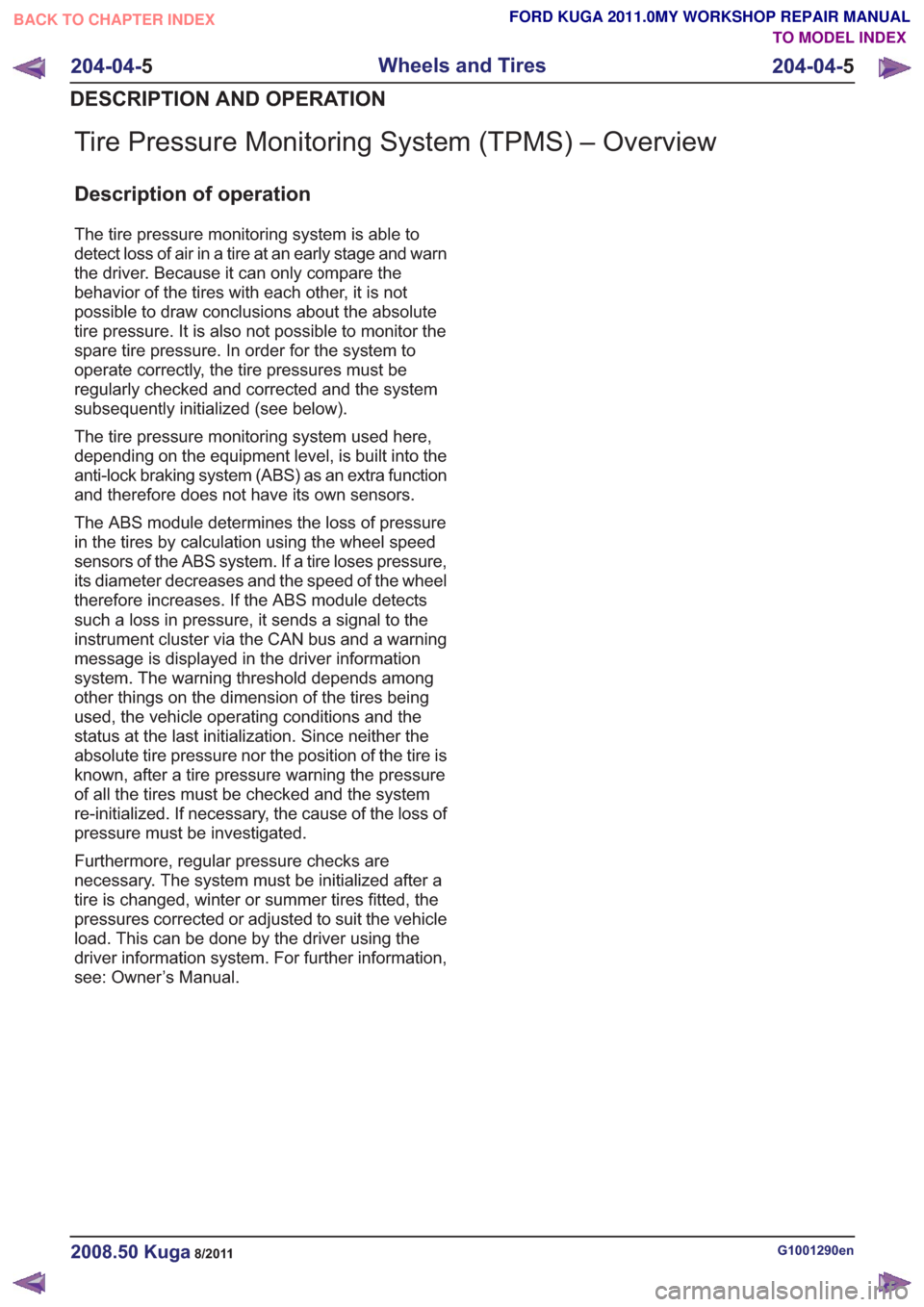Page 1192 of 2057
Wheel Knuckle(14 343 0)
Special Tool(s)204-052
Lever, Wheel Knuckle
14026A
204-602
Installer, Halfshaft
E62067
204-605
Separator, Lower Arm Ball
Joint
E63772
204-609
Protection Cap, Ball Joint
Gaiter
E75372
211-020
Separator, Ball Joint
13006
Removal
NOTE:Removal steps in this procedure may
contain installation details. 1.
E99184
2.
Refer to: Wheel and Tire (204-04 Wheels and
Tires, Removal and Installation).
3.
E99195
4.
E98543
x7
5. WARNING: Make sure that no load is placed on the brake hose.
Torque: 120Nm
G1000209en2008.50 Kuga8/2011
204-01- 21
Front Suspension
204-01- 21
REMOVAL AND INSTALLATION
TO MODEL INDEX
BACK TO CHAPTER INDEX
FORD KUGA 2011.0MY WORKSHOP REPAIR MANUAL
Page 1199 of 2057
E99109
1
204-159
204-605
2
8. WARNING: This step requires the aid ofanother technician.
Torque: 35Nm
E99147
x3
Installation
1.To install, reverse the removal procedure.
G1000210en2008.50 Kuga8/2011
204-01- 28
Front Suspension
204-01- 28
REMOVAL AND INSTALLATION
TO MODEL INDEX
BACK TO CHAPTER INDEX
FORD KUGA 2011.0MY WORKSHOP REPAIR MANUAL
Page 1200 of 2057
Front Strut and Spring Assembly(14 783 4)
Special Tool(s)204-167
Compressor, Coil Spring
14042
204-167-01
Adapter for 204-167
1404201
Disassembly
WARNING: Take extra care when handling
the compressed spring.
1. Install the Special Tool(s): 204-167, 204-167-01
E97819
204-167-01
204-167
1
2
2. NOTE: Note the position of each component
before removal.
E132038
G1000221en2008.50 Kuga8/2011
204-01- 29
Front Suspension
204-01- 29
DISASSEMBLY AND ASSEMBLY
TO MODEL INDEX
BACK TO CHAPTER INDEX
FORD KUGA 2011.0MY WORKSHOP REPAIR MANUAL
Page 1201 of 2057
Assembly
WARNING: Take extra care when handling
the compressed spring.
3. To assemble, reverse the disassembly
procedure.
4. NOTE: Only tighten the nut finger tight at this
stage.
E98495
5. NOTE: Make sure that these components are
installed to the noted removal position.
NOTE: Make sure that the spring is correctly
located in the lower spring seat.
NOTE: Make sure that the installation marks
are aligned.
E131947
G1000221en2008.50 Kuga8/2011
204-01- 30
Front Suspension
204-01- 30
DISASSEMBLY AND ASSEMBLY
TO MODEL INDEX
BACK TO CHAPTER INDEX
FORD KUGA 2011.0MY WORKSHOP REPAIR MANUAL
Page 1208 of 2057
Wheel Bearing and Wheel Hub
Removal
NOTE:Removal steps in this procedure may
contain installation details.
1. Refer to: Wheel and Tire (204-04 Wheels and
Tires, Removal and Installation).
2. Refer to: Rear Wheel Speed Sensor (206-09
Anti-Lock Control - Stability Assist, Removal
and Installation).
3. WARNING: Make sure that no load is placed on the brake hose.
E100132
4x4
4.
E101209
5.If equipped.
E134127
All vehicles
6.
E99212
G1001323en2008.50 Kuga8/2011
204-02- 6
Rear Suspension
204-02- 6
REMOVAL AND INSTALLATION
TO MODEL INDEX
BACK TO CHAPTER INDEX
FORD KUGA 2011.0MY WORKSHOP REPAIR MANUAL
Page 1209 of 2057
7.
E99213
1
x4
2
3
4
5
Installation
1.Torque: 110Nm
E133879
1
2
3
4
2.
E99212
4x4
3. NOTE: Only tighten the bolt finger tight at this
stage.
E101209
All vehicles
4. WARNING: Make sure that no load is placed on the brake hose.
Torque: 110Nm
E134113
G1001323en2008.50 Kuga8/2011
204-02- 7
Rear Suspension
204-02- 7
REMOVAL AND INSTALLATION
TO MODEL INDEX
BACK TO CHAPTER INDEX
FORD KUGA 2011.0MY WORKSHOP REPAIR MANUAL
Page 1231 of 2057

Run-Flat Tires – Overview
Tires with Run-flat Properties
E68867
2
1
3
2
4
1
3
BA
Description
Item
Standard tire after pressure loss
A
Tire with run-flat properties after pressure
loss
B
Wheel position with correct tire pressure
1Description
Item
Wheel position with insufficient tire
pressure
2
Tires
3
Reinforced sidewall
4
In addition to the standard tires, run-flattires are
also optionally available. These tires have a
reinforced sidewall and provide the advantage that
the tire maintains its shape to a large extent even
in the event of insufficient tire pressure. This
ensures that the vehicle handling remains stable.
Advantage:
• These tires maintain their shape to a large extent, even in the event of insufficient tire
pressure. This ensures that the vehicle handling
remains stable.
Special wheel rims (EH2) and a tire pressure
monitoring system are needed for run-flat tires.
Standard tires can also be installed on the EH2
(EH = Extended Hump) wheel rims. Tires with
run-flat properties have the same size code and
the same appearance as standard tires.
With some tires, the code RFfor run-flat is included
in the tire designation, e.g. 205/55 RF16. Tires with run-flat properties have various different
codes on the sidewall, depending on the
manufacturer.
• The RFT logo
• "RUNFLAT" as an additional designation
• The additional designation "RSC" (RSC =
Runflat System Component)
• The additional designation "SSR" (SSR = Self
S upporting Run-Flat-Tire)
• The additional designation "SST" (SST = Self
S upporting Run-Flat- Tire)
WARNING: If a tire with run-flat properties
is used without air then the vehicle speed
must not exceed 80 km/h and the vehicle
must not be driven for distances in excess
of 80 km.
Note: Vehicles equipped at the factory with run-flat
tires do not feature a tire repair kit or a spare wheel.
G1000256en2008.50 Kuga8/2011
204-04- 4
Wheels and Tires
204-04- 4
DESCRIPTION AND OPERATION
TO MODEL INDEX
BACK TO CHAPTER INDEX
FORD KUGA 2011.0MY WORKSHOP REPAIR MANUAL
Page 1232 of 2057

Tire Pressure Monitoring System (TPMS) – Overview
Description of operation
The tire pressure monitoring system is able to
detect loss of air in a tire at an early stage and warn
the driver. Because it can only compare the
behavior of the tires with each other, it is not
possible to draw conclusions about the absolute
tire pressure. It is also not possible to monitor the
spare tire pressure. In order for the system to
operate correctly, the tire pressures must be
regularly checked and corrected and the system
subsequently initialized (see below).
The tire pressure monitoring system used here,
depending on the equipment level, is built into the
anti-lock braking system (ABS) as an extra function
and therefore does not have its own sensors.
The ABS module determines the loss of pressure
in the tires by calculation using the wheel speed
sensors of the ABS system. If a tire loses pressure,
its diameter decreases and the speed of the wheel
therefore increases. If the ABS module detects
such a loss in pressure, it sends a signal to the
instrument cluster via the CAN bus and a warning
message is displayed in the driver information
system. The warning threshold depends among
other things on the dimension of the tires being
used, the vehicle operating conditions and the
status at the last initialization. Since neither the
absolute tire pressure nor the position of the tire is
known, after a tire pressure warning the pressure
of all the tires must be checked and the system
re-initialized. If necessary, the cause of the loss of
pressure must be investigated.
Furthermore, regular pressure checks are
necessary. The system must be initialized after a
tire is changed, winter or summer tires fitted, the
pressures corrected or adjusted to suit the vehicle
load. This can be done by the driver using the
driver information system. For further information,
see: Owner’s Manual.
G1001290en2008.50 Kuga8/2011
204-04-5
Wheels and Tires
204-04- 5
DESCRIPTION AND OPERATION
TO MODEL INDEX
BACK TO CHAPTER INDEX
FORD KUGA 2011.0MY WORKSHOP REPAIR MANUAL